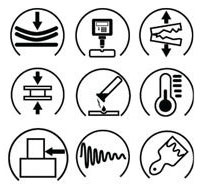
Polyurethane’s Temperature Range
Minimum and maximum operational temperatures
Why It Matters
Many applications call for operation above or below room temperature. This is not an issue for polyurethane — it sees action from the arctic to the jungle. But a polyurethane component’s size and performance properties do vary with temperature. To minimize temperature’s impact, we design for your application’s anticipated environment.
Measurement
One measure of the performance properties of polyurethane is Dynamic Mechanical Analysis (DMA). The DMA gives an indication of performance properties over a wide temperature range.
The DMA test dynamically strains a sample of polyurethane to measure both its storage modulus and loss modulus. When polyurethane is strained, some of the energy is stored (“storage modulus”) due to polyurethane’s elastic nature. Likewise, some energy is lost as heat (“loss modulus”) due to its viscous nature. Storage modulus and loss modulus change with temperature. These properties are important because they help define polyurethane’s performance at different temperatures.
Typical Values
In general, polyurethane can be used in the temperature range of -62°C to 93°C (-80°F to 200°F). Special formulations can extend polyurethane’s performance reach to as high as 150°C (300°F).
High-Temperature Operation
We select the optimum polyurethane formulation to ensure dynamic performance at high temperature.
In general, polyurethane’s dynamic performance properties become significantly degraded at temperatures above 93°C (200°F). Special polyurethane formulations can provide performance at temperatures as high as 150°C (300°F). Note that performance degradation due to temperatures up to 93°C (200°F), even when endured for several weeks, is almost completely reversible once the temperature is decreased back into the typical operating range. Exact values depend on the polyurethane formulation.
The following conditions will all irreversibly degrade polyurethane and should be avoided:
- Short-term exposure to temperatures above 180°C (350°F)
- Long-term exposure to humid environments greater than 70°C (158°F)
- Exposure to steam
Low Temperature Operation
We select the optimum polyurethane formulation to ensure dynamic performance at low temperature.
Polyurethane’s modulus gradually increases as the temperature is reduced below -18°C (0°F), which increases its stiffness and impacts other performance properties. In general, brittleness becomes an issue around -62°C (-80°F). Exact values depend on the polyurethane formulation.
Thermal Expansion (or Contraction)
Polyurethane expands (or contracts) based on the environmental temperature. Unfortunately that’s physics and can’t be avoided.
Polyurethane’s expansion is roughly the same order of magnitude as rubber, and about 10 times that of steel. Polyurethane’s coefficient of linear thermal expansion typically ranges from 1.4 x 10-4 to 2.5 x 10-4 mm/mm/°C (0.8 x 10-4 to 1.4 x 10-4 in/in/°F). Exact values depend on the polyurethane formulation and environmental temperature.
Dimensioning and tolerancing of your product can be very important with respect to temperature. Dimensions and tolerances need to account for the expansion caused by the anticipated temperatures of your application. Tight tolerances are not required for every project. Identifying the loosest acceptable tolerance is more accommodating to temperature variation, and can also reduce manufacturing cost. We will assist you with accounting for thermal expansion (or contraction) in your product’s design.



